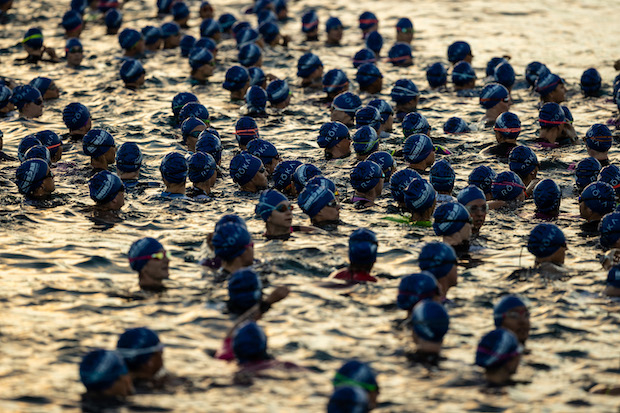
Earlier this week IRONMAN announced changes to the women's qualification cycle for the 2024 IRONMAN World Championships in Nice, France. Like most things related to IRONMAN, the changes were met with mixed reaction, such as a thread on our forum that now has over 100 responses in it. That said, if you take a longer look at IRONMAN's own history, these changes fit directly into that narrative. And furthermore: they're good for the sport.
What Changed
To recap: for 2024, there are new pathways for women to qualify for the IRONMAN World Championships in Nice. These pathways supplement the existing qualification method of finishing in a high enough position within your age group at an IRONMAN race; slots are awarded based on proportional allocation off of number of starters per age group. These slots can, and have, rolled down through age groups, for both men and women; as in, either slots roll towards lower classified athletes, or nobody takes the slot in its entirety.
Now, for the three "new" methods:
Top 10 in Age Group at Kona: The top ten finishers in each age group from this month's IRONMAN World Championships will be offered a 2024 worlds slot. A validation race is required (meaning yes, you still need to go do another event), but it takes the qualifying pressure off of the table. Notably, these slots can't roll -- meaning if someone in the top 10 doesn't take the slot, that slot doesn't go to athlete in 11th place.
IRONMAN 70.3 Events: Selected IRONMAN 70.3 events will have invitational slots on offer. These slots will reward the top five finishers in each age group. And no, those slots won't roll through age groups, either.
All World Athlete Rankings: Top of age group athletes in the finalized 2023 All World Athlete Rankings will be offered a Nice entry; again, these will not roll, and they require a validation race.
In the announcement, IRONMAN CEO Andrew Messick said that these changes were a response to what they saw transpire at the 2023 IRONMAN World Championships. “In looking beyond traditional qualifying slot allocation, we will recognize exceptional skill, ability, and dedication, while also maintaining the integrity of the VinFast IRONMAN World Championship as the ultimate stage for the fastest and most competitive athletes in the sport. The 2023 women’s VinFast IRONMAN World Championship showcased this, and we are excited to provide additional qualifying opportunities to attract more athletes that can perform at a world championship level to the 2024 VinFast IRONMAN World Championship in Nice next September.”
What's Old is New Again
I put "new" in quotes before because, as mentioned, these changes align with the precedent of qualifying for the IRONMAN World Championships. As Dan mentioned in his piece about respecting IRONMAN's own history, change is the constant. We went from an event with zero qualification method at all -- zero, you just had to get your entry in on time -- to being able to qualify at all types of triathlon events. We are not that far removed from being able to qualify at large Olympic-distance events.
We're even closer to our own history with regard to being able to qualify at IRONMAN 70.3 events. It is only in the last decade, with the addition of more and more full-distance races, that IRONMAN World Championship slots stopped being awarded at races like Eagleman. Heck, there are still limited slots available in Hawaii. This isn't a bug of the system. It's a feature. Change happens.
Why now
IRONMAN's instituting these changes in part because they have a demographic dilemma. North America has the greatest number of women participating in IRONMAN events. The United States also sent the largest number of athletes to Nice for the men's World Championship race this year. For there to be a successful event, North American women are going to need to show up in numbers similar to those of men -- roughly half the field.
And the qualification cycle, as it stood, was...messy.
As Kelly O'Mara wrote over at Triathlon-ish, the qualification cycle in North America is simply over concentrated in the back half of 2023. Given Kona's date, you would expect fewer women to race events like California, Florida, and Arizona. And at least in the case of California, that came to pass, with less than 25% of the field being women.
There's also a sense of trying to push on the concept of who "deserves" to race an IRONMAN World Championship. (Nobody deserves anything, but that's a story for another time.) Despite the extraordinary statistics around swim course completion under cutoffs and the overall course finish rate, IRONMAN was sensitive to the concept that there were women who had not "properly" earned their slot by being fast enough. All three of these new changes are to specifically target the top of the top end of the field, with "normal" qualification cycles (which, note, some full distance IRONMAN races will have fewer slots for women than initially announced) filling the rest of the ranks.
Ultimately, I side on having more women racing at championship level events. We've seen this pay dividends with events like the US Marathon Trials, where there's greater interest with larger fields. And hopefully, as Dan wrote last fall, "The optics of a world championship, with thousands of women both age group and pro swarming any Mediterranean location for this race could be a Title IX moment for that region.
I will certainly want to be there to spectate that."
Photo: Kona 2023 Swim Start by Korupt Vision
